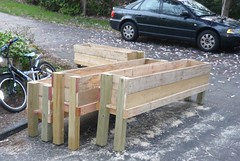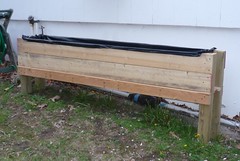I think that the most telling was Jeff, Warren, and I sharing the same thoughts pretty much immediately after crossing the finish line, which was something along the lines of “Well, I think full on Ironman is never going to happen.”
Which wasn’t an acknowledgement that it wasn’t within our capabilities, but was more of an acknowledgement that the commitment to 140.6 was light years beyond our willingness to commit to the training, time, and suffering necessary to do the race right. But more on that later. Specific race observations that might be useful to someone else approaching the 70.3 distance:
1. The swim base is pretty easy to get. I was swimming 3 times a week between 1.5K and 2K from January to March, and dropped down to twice a week from March through the race, as it was nice outside and I swapped a swim for a bike each week. While the Mooseman swim was in a pretty sheltered bit of cove, I’m not sure that more open water swimming would have helped much with the lake swim. Maybe if it’d been an ocean swim, which I think the Hip would corroborate.
2. If could go back to February and redo 10 workouts between then and the race, I’d cut out a couple of my 10+ mile runs and do them as bike/run bricks. The transition between bike and run just plain sucks if you haven’t been doing it – the back needs to learn to go from completely stretched on the bike to vertical on the run. The first time I realized I had lumbar muscles was about 400 yards into the run when they seized up.
I did several run/swim bricks, but, frankly, I don’t think the transition from swim to run is really that tough. Swimming’s low physical impact. Although it’s critical to do a lot of it to build good form and not blow all your energy in the swim, I don’t think there’s much other than making sure you’re under LT to make going from swim to bike difficult.
On the other hand, instead of the 10+ mile runs, I’d like to do many more workouts of 60-90 minutes on the bike followed by 3-6 miles of running. I think that the individual bike and run workouts during the week (40-90 minutes bike and 4-7 miles running) built and maintained enough of an aerobic base to get through the race, and that bike/run bricks, starting with 15 mile/5 mile goal in February (1 hour on the trainer, 5 miles bundled up on the road) lengthening to a 40 mile/10 mile brick 2 weeks before the race would have been immensely useful.
3. I think Warren’s approach to transition was brilliant. Even if I’d been shooting for 6 hours (or 5.5 hours like Zipper), the difference between 7 minutes total in transition or 14 minutes in transition translates to minor, minor performance improvements in each event. Stretch, fuel, and move out. Plus, I would have had sunglasses on the bike, and wouldn’t have squinted or worried about catching a rock in the eye.
4. Mooseman was exceptionally well supported. In hindsight, I wish I’d considered nutrition more. I don’t know what I would have done in a less posh race situation. Much of my bike training relied on cash and convenience stores.
5. Wish I’d taken Actafed the night before to help sleep/ease congestion, and a Claratin the morning of the race. Snot sucks.
I suppose I could go to some good number like 10 tips, but that’s about all I really learned in the race that I didn’t capture in last week’s post. There are a couple of personal observations to make, though:
Initially, I’d approached Mooseman as a chance to really get in shape; a chance to go to the next level in training. But, as the race approached, and as life continued to intrude, I realized that I was spending a lot of time training in order to just survive 70.3 miles. Training for peak performance would have required at least twice as much time as I had to commit, and just wasn’t going to happen.
So, in my mind it became fine just to finish this race. And I’m thrilled with the outcome.
This is my last half ironman for quite a while, though. After 5 years of relative dedication to fitness (WOW – really? 5 years of being pretty consistent with running?) I think I ought to move past ‘finishing’ as a goal and actually try to improve. Improve weight and BMI, improve finishing times, and generally go from being a guy who runs to support poor eating habits to just being a guy who runs well.
The best long-term outcome from this race is that I’ve realized that I LOVE a 6 day training schedule, and love doing a run and a swim on the same day (or a bike and a swim) at least twice a week. I remembered why I love cycling – the symphony of person and machine, the animate and the inanimate merging like yin and yang into something greater than the two parts, and will not be happy unless I’m doing it more this summer.
But I’m not committed enough to give more than 3 hours of my weekend over to training. I love the time with the kiddos, I love the time with the church, and I love puttering around the yard instead of being alone training.
A good (for me – shooting for around 4 hours) marathon can be done on a schedule of 7-9 hours a week. A good Olympic triathlon can be done. And great sprint tris can be a part of that training schedule.
But, unless I can come up with some quantum breakthrough short of HGH, EPO, and crystal meth, there’s no way that schedule is going to support anything beyond finishing a half ironman for me (as has been proven).
I’m trilled to have done Mooseman, and it’s no exaggeration to say that this is the first race I’ve done for which I think I’ve accomplished something significant by training for and finishing. I’ve written before about my letdown with finishing marathons and not hearing choirs of angels while I crossed the finish line, about not feeling “changed” by completing a marathon. Mooseman did show me that there’s a whole other level of potential I haven’t tapped in my psyche. That’s one reason why it’s the first medal I’m really proud of.
But it’s going to be a long, long while before I do 70.3 again. The kids are going to have to start ignoring me on the weekends, and I’ll have to have the HoneyDo jar cleaned out.
So, I figure some time around 2050 or so,





